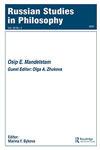列夫·卡尔萨文论革命现象学
IF 0.1
4区 哲学
Q4 Arts and Humanities
引用次数: 0
摘要
本文试图在俄国革命形而上学的大背景下分析卡尔萨文的革命理论,以确定卡尔萨文的革命现象学在其著作和欧亚主义意识形态中的地位。他的文章《革命现象学》在本体论上联系了卡尔萨文理解中的两个关键概念:“交响乐人”和“统治阶层”。革命的意义在于引导交响乐的人去实现他的主要任务,这些任务要求他尽最大的努力,并且与他的历史形式的存在本身有关。这种危机可能导致一个人的死亡,但在老人的死亡中诞生了一种新的个性化,一种更高层次的人格,对他来说,这种革命是一种重生。如果交响乐人成功地“死而复活”,那么这也将是一个新的统治阶层和一个新的政府的诞生,即它作为国家的新存在。卡尔萨文由此明确了交响人物和统治阶层的历史功能。后者是交响乐人的一种整体,为一般概念提供了自己的个人内容。统治阶层的概念是在交响乐人理论的形而上语境中解释的。根据交响乐人的使命,统治阶层是活跃的社会文化人群中个体之间的有机联系,与历史精神和人民精神产生共鸣。在这种情况下,阶层与政党和机构一起“统治”,最终对它们做出判断。卡尔萨文工作的主要成果是:(1)模拟革命的发展阶段;(2)统治阶层的概念,这使我们能够避免对活跃精英的正式社会学理解,并将我们的注意力引导到个人活动与在关键时期表现出来的“沉默”但绝不是“沉睡”的民族基础之间的联系。本文章由计算机程序翻译,如有差异,请以英文原文为准。
Lev P. Karsavin on the Phenomenology of Revolution
ABSTRACT This article attempts to analyze Karsavin’s theory of revolution in the broader context of a Russian metaphysics of revolution in order to determine the place of Karsavin’s phenomenology of revolution both in his work and within Eurasianist ideology. His article “Phenomenology of Revolution” ontologically links two key concepts within Karsavin’s understanding: the “symphonic person” and the “ruling stratum.” The meaning of revolution consists in leading the symphonic person to a realization of its main tasks, which require the utmost exertion and are related to the very existence of its historical form. This crisis can result in the person’s death, but in the death of the old person is born a new individuation of a higher order of personhood for whom that revolution has been a rebirth. If the symphonic person succeeds in “being revived through death or recovery,” then this will also be the birth of a new ruling stratum and a new government, that is, its new being as a state. Karsavin thus clarifies the historical functions both of the symphonic person and of the ruling stratum. The latter turns out to be a kind of entelechy of the symphonic person, providing its own personal content to the generic concept. The concept of the ruling stratum is explained in the metaphysical context of the symphonic-person theory. In light of the symphonic person’s mission, the ruling stratum is an organic connection among individuals of the active sociocultural segment of the population that has resonated with the spirit of history and the people. In this case, the stratum “rules” along with parties and institutions, eventually passing judgment on them. The main results of Karsavin’s work are (1) modeling a developmental phase of revolution and (2) the concept of the ruling stratum, which allows us to avoid formal sociological understanding of the active elite and direct our attention to the connection between personal activity and the “silent” but by no means “sleeping” substrate of the nation that manifests itself in critical epochs.
求助全文
通过发布文献求助,成功后即可免费获取论文全文。
去求助
来源期刊

RUSSIAN STUDIES IN PHILOSOPHY
PHILOSOPHY-
CiteScore
0.10
自引率
0.00%
发文量
14
期刊介绍:
Russian Studies in Philosophy publishes thematic issues featuring selected scholarly papers from conferences and joint research projects as well as from the leading Russian-language journals in philosophy. Thematic coverage ranges over significant theoretical topics as well as topics in the history of philosophy, both European and Russian, including issues focused on institutions, schools, and figures such as Bakhtin, Fedorov, Leontev, Losev, Rozanov, Solovev, and Zinovev.
 求助内容:
求助内容: 应助结果提醒方式:
应助结果提醒方式:


